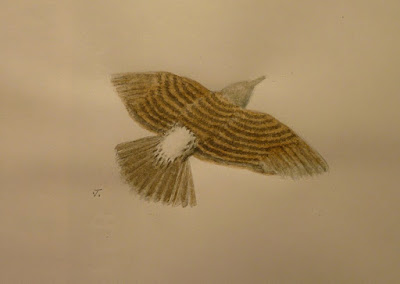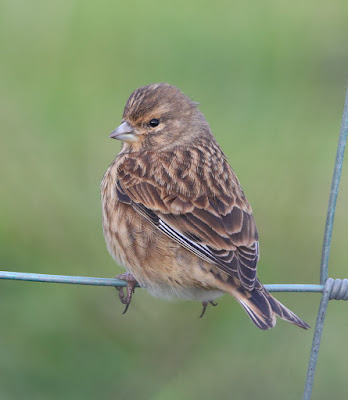2018 continues in the same vein as 2017. Rain, more rain and then more rain with rarely a chance for serious birding or ringing.
Fortunately the internet can be a good source of blog material, so for today here is an amusing tale of a controversial bird that may have escaped the twitchers but which certainly provoked a reaction.
Such debates are made all the more interesting by the fact that rare birds can and often do turn up in the most unexpected locations, posing a number of questions for dedicated twitchers. In the case below the bird in question was spotted on a remote Scottish island following a particularly wild and wet autumn when a series of storms battered the west coast of Britain.
Orkney is difficult to reach and for a mainland twitcher with no time to waste in bagging a First for Britain, an expensive and time consuming trek that involves road, boat and plane.
Stronsay, Orkney
Let’s start at the beginning with the finder’s description of a bird on the Scottish island of Stronsay, Orkney on December 2nd 2017.
Stronsay Report
"The biggest surprise came on 2nd December! Whilst driving home we were startled by a large unfamiliar Jay sized bird flying up from the short-lawned area adjacent to the garage at Lower Millfield. We had excellent views for just 8 -10 seconds as it first sprung up from the short grass alongside us, over the hedge at Millburn Cottage.
We were completely stumped but certain it was a species neither of us had seen before. A bird springing up in that fashion here in winter is almost always either a Snipe or a Woodcock but this bird was less bulky than Woodcock and too big for Snipe and although the pattern on the upperparts (including the innerwing) were a similar black barred dark brown its bill was far too short and its fanned, rounded tipped tail too long for Woodcock. The colour was clearly wrong for Jay but the size, wing shape and proportions similar. The main feature however was the startling white rump, a square sided rectangle longer than it was broad which positively gleamed at us and probably why our minds went immediately to Jay as it rose from the ground
We searched the internet but were finally pointed in the right direction by an old friend who lived in the United States for 12 years or so.
“Sounds like a Northern Flicker to me” he suggested. Within a few seconds we had discovered page after page of photos of the species on the computer and there was now no doubt in our minds it was a Northern Flicker!
Northern Flicker
"A day or so later we popped in to Helmsley to tell of our sighting. Eyes lit up “Ah... the Flicker bird”, she smiled. “I’ve seen those in our daughter's garden in North America”. Not only that she disappeared into a back room for a few seconds and when she emerged, presented me with a wing feather of the species she had picked up whilst there some years ago!
There have been 3 or 4 records of the species in the UK all found dead on or near the shoreline (one in Caithness) and all idling in the category of ship assisted species. If our bird was ship assisted it did at least make landfall.”
It appears there was delay or non-urgency in announcing the news to the birding world followed by an unusual lack of interest.
Fast forward to an Internet bird watching forum of 22 January 2018 and a plea to contributors “please discuss” - “Best bird of the year - a Northern Flicker seen briefly at very close range in the Reserve Drive on 2nd December, and a sketch.”
Northern Flicker?
There follows a number of less than enthusiastic, even contemptuous comments about the reliability of the sighting, the expertise of the claimants and the history of bird recording on the Orkney island. In fact there followed a wholesale trashing of the record.
“Don't think there's much to talk about...!”
“Quite. Maybe if somebody wants to make a case for it, otherwise it feels like going over very old ground.”
“And of course, the tail shape in the drawing conclusively excludes any woodpecker other than perhaps Wryneck”
“Are they just bad birdwatchers, bullshitters or 100% true?”. (Reply) “A bit of the first, a lot of the second and none of the third.”
“Given the poor Autumn would undoubtedly have been Bird of the year...shame news wasn't released earlier...or is transport/access (even via Charter) very difficult?”
“Are you familiar with the history of Stronsay bird recording?” (Reply) “I'm not. Gets can opener and somewhere to pour the worms”.
“Nobody would have travelled”.
“What is the bird in the sketch? Badly seen Fieldfare/Starling/Brambling? Who knows but a tad unlikely that it was a Northern Flicker. It would have been his 12th first for Britain then?”
“How many have been recorded in UK and Ireland?”
“Just as an example, there were no accepted BB rarities for Stronsay in 2002 yet their annual report includes breeding Icterine Warbler, not one but two Rufous Turtle Doves, Spanish Sparrow, White-billed Diver, Collared Flycatcher, a couple of Gyrfalcons and lots of other great rarities.”
“Still it’s things like this that keeps us entertained and looking forward to the next instalment of nonsense.”
“It is tempting to go out there, and get a true feel for the place. But then, you would be on a hiding to nothing. If you found something good, it would kind of validate all the previous or you would be lumped in with all the previous”.
“Indeed - good birds still do turn up on Stronsay. From memory, the website had good pics of Pallid Harrier, Red-breasted Goose, and Greenish Warbler, enough to put a smile on your face if you found one. And of course, plenty of good 'scarce' among the less convincing photos of other claimed rarities.”
North America Occurence
The Northern Flicker is widespread across North American and is one of the few woodpeckers that is strongly migratory. Flickers in the northern parts of their range move south for the winter, although a few individuals often stay rather far north.
Northern Flicker range
British Occurence
A decomposed corpse believed to have been brought ashore in Caithness in July 1981 is regarded as a human-assisted transportee. (BOURC 38th Report). This same report has a photo of a Northern Flicker taken in 1962 on board a ship crossing the Atlantic. At the start of the crossing there were at least ten Northern Flickers and more than 120 other Nearctic landbirds on board. The Flicker was the last to survive despite sustenance being provided by the crew and it departed the ship once it had docked in Ireland.
Well, I’m glad I’m not a twitcher. So many decisions, so much potential heartache and never quite knowing if you did the right thing.
Stay tuned, Friday may not be raining and I'll return with local news.
Linking this post to
World Bird Wednesday.

































































.jpg)














